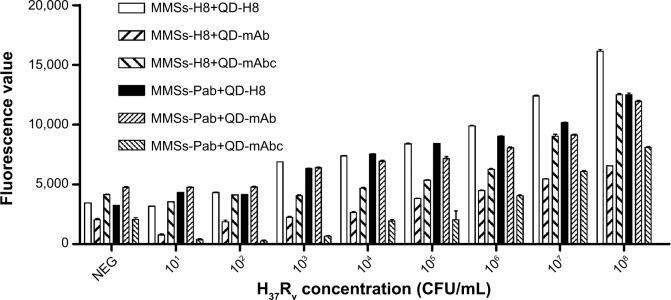Figure 5.

LOD detection for six combinations of MMSs coupled with H8 or Pab and QDs conjugated with H8, Mab, or mabc.
Notes: Differences in MTB detection capability between the combinations were evident for a range of MTB concentrations in the test. Combinations of MMS-H8+QD-mAb and MMS-Pab+QD-mAbc produced a strong signal for only 107 CFU/mL H37Rv cells, indicating relatively poor MTB detection capability. Combinations of MMS-H8+QD-mAbc and MMS-Pab+QD-mAb exhibited a higher but decreasing fluorescence intensity of H37Rv for 105 CFU/mL or 106 CFU/mL, showing improved MTB detection capability. Combinations of MMS-Pab+QD-H8 and MMS-H8+QD-H8 yield a significantly higher signal for 103 CFU/mL H37Rv and thus demonstrated the best MTB detection capability.
Abbreviations: LOD, limit of detection; MMSs, magnetic microspheres; QDs, quantum dots; Pab, a rabbit polyclonal antibody against MTB; mAb, a murine monoclonal antibody against MTB; mAbc, a murine monoclonal antibody against MTB heat shock protein 65 (HSP65); CFU, colony-forming unit; mAbc, .
